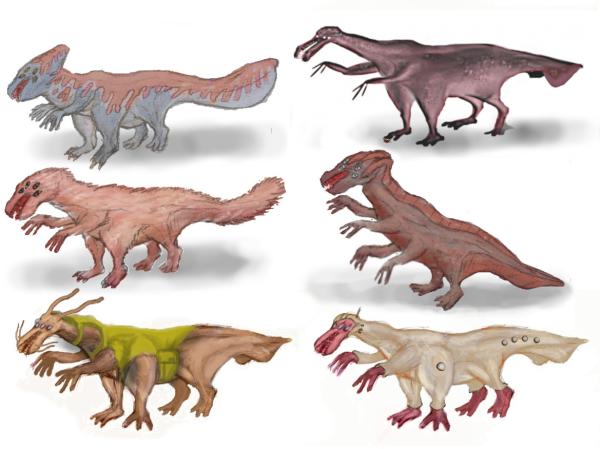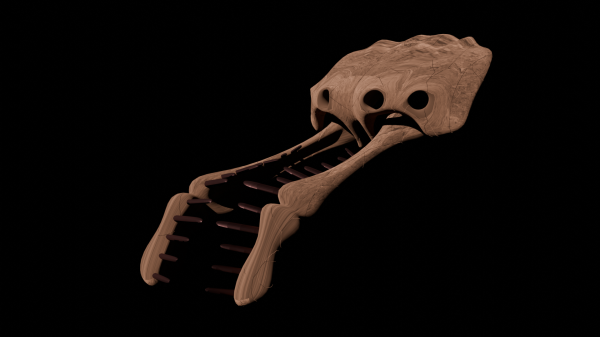BY LETTER
Thiogens
 Image from Worldtree Steve Bowers | |
| Several artists' reconstructions of what Thiogens might have looked like, based on a variety of incomplete remains. Whether Thiogens displayed anywhere near the variation of even human nearbaselines remains unclear. These reconstructions are mostly conjecture, as no uncontested fossils of the species have yet been found | |
The Thiogens were a xenosophont clade and are believed to have gone extinct 560 million years ago. They were first hypothesized in 2478 AT to explain the microbial life which inhabited Kate and Xanthippe, two moons of a Neptunian world orbiting a G2 star. The two moons were the first Vitriolic biospheres discovered and possess microbial life which early genetic analysis showed to have diverged from a common ancestor some time before. Evidence for the Thiogens grew in 2543 AT when the first Vitriolic garden world was discovered, LiuShan. This world yielded more significant discoveries in the form of ruins of underground bases on its lone satellite and a barely intact interplanetary spacecraft adrift in the system. The spacecraft, ruined bases and ecoforming all were dated to approximately 560 million years ago. In the centuries since these discoveries, 158 ecoformed Vitriolic worlds have been discovered as well as hundreds of ruined spaceships and asteroid, moon and orbital bases. None has ever been found measurably younger or older than 560 million years. The subsequent discovery of some naturally-occurring Vitriolic worlds gradually came to remove all skepticism to the Thiogen Theory, as they all showed clear genetic, biochemical, cellular and morphological differences in their biospheres.
Analysis of ruined life-support technologies in the spaceships and bases confirm that the Thiogens possessed a Vitriolic metabolism; they breathed an atmosphere of nitrogen, oxygen and CO2 and they imbibed sulfuric acid which averaged 98% pure. Studies of ruined architecture, minor artifacts and what little has been recovered from seriously decayed computer records confirm their basic morphology. Thiogens had four legs, dexterous forelimbs, a balancing tail and a single head on a moderately long neck. The head possessed four eyes spaced evenly on a lateral 180°; arc, their jaw/snout was laterally opposing and of moderate length. The jaw/snout appears to have had one nostril on each the left and right sides and they apparently possesses several kinds of teeth, indicating a possible omnivorous diet. From snout to tail, they averaged 3.65 meters and were 1.52 meters high, taller still if they held their forward body up. Beyond this is conjecture based on comparisons to similar morphologies found on Thiogen worlds.
Little is known of Thiogen culture and technology despite the artifacts present. Their spaceships appear to have been powered and propelled by fusion. Building materials are invariably advanced acid-resistant metal alloys, ceramics and organic silicone "plastics" showing no definitive signs of having been originally crafted by nanotechnology and computer hardware and data fragments suggest only the simplest of sub-sophont AIs were utilized. There is no evidence the Thiogens ever constructed a wormhole network or megastructures of any kind. The technology used in their ecoforming projects is completely unknown, no evidence as to its nature is to be found on any of the worlds in question. There is insufficient evidence to suggest anything at all about their internal politics, beliefs, customs, except perhaps that they were expansionist at some stage of their existence. Every world they ecoformed was given the same original biosphere; there are no examples of Thiogen-ecoformed worlds with life from any other source or that had merely been seeded with basic lifeforms. This suggests that the Thiogens were settling new worlds and bringing their native biosphere with them and that they were not interested in spreading life in general or conducting experiments in planetary engineering. Whether this is an accurate assessment and whether it was a coordinated effort or not is far from certain, hypothesizing the motives of a xenosophont clade of unknown psychology that has been extinct for over half a billion years is no easy task.
 Image from Andrew P. | |
| A fossilized Thiogen skull unearthed on LiuShan | |
It is not known why the Thiogens went extinct; there are many speculations, but no hard evidence for any of them. Some suggest that an ancient equivalent of The Dawn Hunters destroyed them, citing the fact that not even one Thiogen base is intact, despite these bases being built of highly durable materials on inactive celestial bodies of low to minimal gravity, as evidence. Others argue that 560 million years is likely enough time to account for this because, materials aside, the bases still appear to have been relatively crude. Also there is no evidence directly pointing to any weaponry or bombardment aiding in their collapses. Another common speculation is that they simply faded away. Their technology certainly did not rival that of the modern Terragen civilization and many find it easy to imagine such a race slowly fading out on each of its worlds once it stops expanding.
Related Articles
Appears in Topics
Development Notes
Text by Matthew C. Johnson
Initially published on 27 January 2009.
Original Thiogen by Steve Bowers added 2009
Thiogen Variants image added 28 December 2023
Initially published on 27 January 2009.
Original Thiogen by Steve Bowers added 2009
Thiogen Variants image added 28 December 2023






